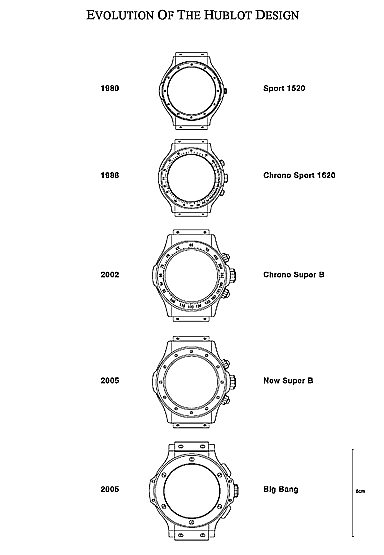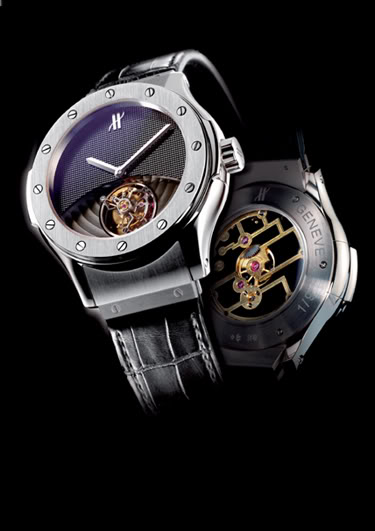ZEN
Rang: Administrateur

Nombre de messages : 57505
Date d'inscription : 05/05/2005
 |  Sujet: Interview with Jean-Claude Biver President of HUBLOT Sujet: Interview with Jean-Claude Biver President of HUBLOT  Ven 29 Sep 2006 - 14:33 Ven 29 Sep 2006 - 14:33 | |
| The exclusive I interviews
Presented by Joël JIDET
Interview with Jean-Claude Biver
President of HUBLOT Jean-Claude BIVER Less than one and a half years after taking over as the head of Hublot, Jean-Claude Biver has succeeded in propelling his brand to the forefront of the watchmaking world, overhauling watch design, launching a television channel and popping up everywhere in the media. Jean-Claude Biver, thank you for agreeing to this interview and to answering questions to satisfy the curiosity concerning the brand over which you preside.
A first question springs to mind. Why did you leave the world of brands that already had a formidable reputation, such as Audemars Piguet and Omega, to preside over the destiny of a brand that two years ago was still little known? This is one of the hazards of youth and ambition. As a young manager I had aspirations, dreams and a great deal of ambition. That is why I left Audemars Piguet when I had just turned 30 (having worked there for four years). I then left Omega in 1981 to buy the Blancpain brand with Jacques Piguet, which had remained dormant for almost 30 years. What we bought was in fact only the right to the name, because of course there was no longer a factory, tools, collection, production, collection, staff, etc. This had been going on for almost 30 years. It was an extinct brand that nobody remembered.You masterminded the renaissance of Blancpain in the 1980s and this time you have breathed new life into Hublot. Are you drawn to brands undergoing a renaissance or is it just chance that your career has led to these watchmaking challenges? I have always taken great pleasure in developing either a product or a brand. This makes me more of a “do-er” than someone who manages an asset. I have to admit that you need both types of managers in the industry. But I am more at home in the field of renaissance and conquest. Above all it gives me greater pleasure.The design of the Hublot collection has evolved a great deal in a few months and some people recognise a certain aesthetic that reminds them of the Audemars Piguet Royal Oak. In your opinion is this the result of your time spent in its manufacture and simply a trend in watch design or a style specific to Hublot? In which case, what makes it different?The form of the first Hublot in 1980. It was the work of Carlo Crocco. He also had the idea of calling the watch (the form of which was inspired by a porthole – ‘hublot’ in French) “Hublot”. Also, and above all, the idea of “fusion” with a rubber strap. This was a brilliant idea and certainly the first fusion in the history of watchmaking. Moreover, it is an idea that has caught on since then, because from Breguet to Swatch, almost all brands have now introduced rubber straps as standard. The form of the Big Bang (if you look carefully and compare it with the 1980 model) is no more than a consummate development of the 1980 version. In other words, if Mr Crocco had developed his original 1980 design, year after year, he would have arrived quite naturally and simply at the Big Bang. This watch is therefore an evolution of the DNA of 1980 enriched by the “fusion” of materials, a new form of construction (sandwich construction) and a dimension (44.5mm for the largest) that suits today’s tastes. 
Big Bang - Détails Two versions of the Big Bang You preach the gospel of lighter watches and the use of materials that optimise weight saving. We see that there are other brands following this route. What makes you think that this is the best route? I do not claim that our route is the best. All routes are good, provided that they have their customers or their market. I simply claim that there are clients who wish to look towards the 21st century and are enthusiastic about innovations and interpretations in harmony and symbiosis with their century and their generation. The price of Hublot watches has risen substantially and the collection is following a fashion trend, which was not the case in the 1980s and 1990s. Don’t you worry that the models have a very marked early 2000 style and that both the designs and the high-tech materials will suffer from the effects of fashion?Hublot already had a very marked style in 1980. And the model has not changed but evolved. We therefore have proof that the model is resistant to the vagaries of fashion, provided that we remain in step with the times. It is rather like the Porsche 911. The basic shape has not changed, but it has constantly evolved in tandem with new technology and tastes and trends over time. Evolution of design in HUBLOT collection Evolution of design in HUBLOT collection Tourbillon white gold Tourbillon white goldCopyright september 2006 - All rights reserved
_________________
Contraria contrariis curantur. (Les contraires se guérissent par les contraires).
|
|
